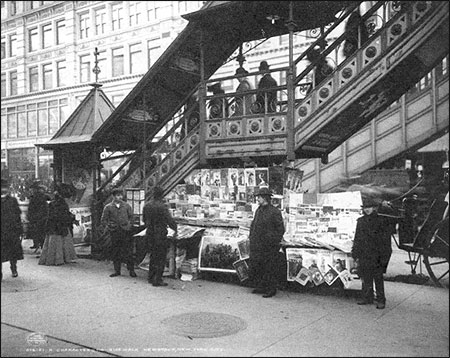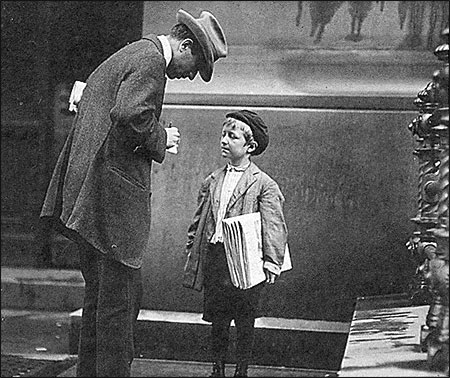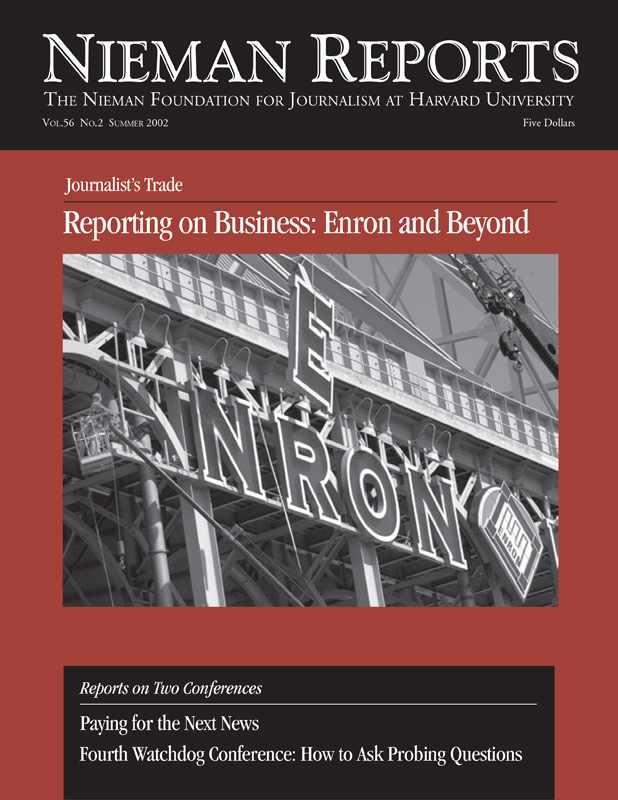
Photo from the Library of Congress, Prints and Photographs Division.

Photo from the Library of Congress, Prints and Photographs Division.

Photo from the National Archives and Records Administration.
Rosabeth Moss Kanter, the Ernest L. Arbuckle Professor of Business Administration at the Harvard Business School (HBS), led conference participants on journeys through change. In some instances, companies embraced change and embedded it into their core business; others felt threatened by the new and clung to the old while gingerly experimenting with change. The lessons for news media are many in a time when technology and the economy are making innovation necessary. In edited excerpts from her talk, Kanter shares her findings and insights.
RELATED ARTICLES
"The Change Journey: The Laggards"
"The Change Journey: The Pacesetters"
- Rosabeth Moss KanterRosabeth Moss Kanter: I want to take you through the change journeys of two kinds of companies. I was looking specifically at how established companies incorporated the technology into their business. This did not mean making a business of the Internet, it meant responding to change.
I had a global survey to which 785 companies, skewed toward China, North America, and Western Europe, responded. We did over 300 interviews and did classic in-depth HBS case studies of nearly 80 companies. The rough division of companies was between pacesetters and laggards. The pacesetters seemed to be ahead of change—capturing more benefits of change and often spending less to get there. The laggards were behind the competition and had more internal struggles about change. And when the laggards incorporated new technology into their business, it cost them more, and they often didn’t get the benefit.
I want to tell you one transformation story about a media company. It has in it all the seeds of what I think are really important. It’s the transformation of Reuters between 1994 and 1999 from an old economy to a new economy company. Now I realize that they’re different because they have, from their beginnings in the middle of the 19th century, all they’ve done is offer information over networks. They were incredibly threatened by the Internet. It was a huge threat because if people could get on public networks what they were charging to get on private networks, they were out of business. Also, their main business and driver is not the public news, it’s financial information for which they can charge a really big premium price because people really need to use it. And that creates synergies with the other reporting that they’re doing and sending out over the wire.
They had a very visionary middle manager named John Taysom. He’d been commissioning small technology projects for Reuters because they’d always had to invest in some new technology to keep delivering their product. He realized that when you commission a project, you get what you already know to ask for. Instead, he said, “In times of uncertainty, when the technology is changing so quickly, the opportunities are changing so quickly, we don’t want what their last idea was, we want their next idea. And we want to use those ideas to help enrich the thinking of our company.” So John goes to Silicon Valley in 1994 and, his first week in California, he goes to the Stanford University cafeteria. He’s reading the student newspaper, and he reads about two young guys named Jerry Yang and David Filo who are still in their dorm room at Stanford.
And he tried to buy Yahoo!. Well, there were two problems with that. One was Yang and Filo didn’t want to sell and the second was Reuters didn’t want to buy. His bosses in London thought he was out of his mind. Totally out of his mind. What Reuters did was form a partnership with Yahoo!. It was some investing, but it was really a partnership where the idea was that Yahoo! would figure out how its technology could be of value to Reuters and Reuters would then put its news on Yahoo!. That made Yahoo! because, back in the early days, without that there wasn’t enough reason to go to Yahoo!. And it made Reuters a brand in the United States in a way that it hadn’t been.
Taysom’s principle was you dream your worst nightmare and then invest in it: Figure out what could hurt you and then figure out how to bring that inside. What started to happen over time was the company was changing without anyone ever having said, “We’re changing.” It happened organically. The amount of learning that came with the incorporation of change inside the company was incredible. It meant that in 1999, Peter Job could stand up and say, “We’re now an Internet company, and we now have infused the new consciousness in every aspect of our business.” What’s striking about this was they did not know in the beginning where they were headed. They didn’t have a plan.
This is improvisational theater rather than traditional theater. There is no script. You don’t spend all your time writing the script, giving it to actors to rehearse, and then rolling it out when it’s new and uncertain. You just do. You experiment. These are all small-scale experiments, and you need a variety of them, a lot of them, because you don’t know which will work. You need to be much more attentive to which will work. And you need the mainstream of the company wanting the results of this experiment because it’s going to improve what they do. So if you have new business models that somehow improve something for the newsroom, they’re going to be with you. And if you don’t, they’re against you. And the antagonism and the resistance grow.
Innovation is not necessarily something that you can know in advance what it looks like, but your customers, your audiences, your executives, say, “That’s it.” Or “I’ll know it when I see it.” And that’s how a lot of great companies transform. They don’t announce a big change effort or a huge shift of strategy. What they do is they start experimenting. They have a series of innovations, a series of projects, a series of ventures. And you need more than one. Successful companies start moving. And that’s the difference. They improvise. Call it rapid prototyping—putting out lots of experiments, getting feedback from customers, and continuing to move. They also work through partners. They don’t think about going it alone and often use a wider set of partners in many more places. That’s what will save the middles that we’re talking about driving out.
So much of this conversation has said repeatedly that you don’t want to get caught in the middle. That you’re either really global or intensely local. You’re either really big in a conglomerate or you’re small and focused. News is either free or very expensive. You don’t want to get caught in the middle. The way you can avoid it if you’re middle-sized is through a network of partners and being much more open to who those partners are—and they can be a variety of kinds. They can be companies like you. They can be companies that are very different. Companies that are most innovative are the most willing to have structural flexibility internally. They are less territorial either because they’ve created a culture of shared values across all areas or they move people around. That’s more important than whether they have common incentives like stock options. But that doesn’t hurt, either. But they do have a culture that allows them to think about themselves as one enterprise rather than parts of their individual units.
Bob Giles: I’m trying to figure out the relationship between the Reuters model and Yahoo!. Reuters is a global corporation and Yahoo! represents a global threat. But then Knight Ridder company is made up of small and big community newspapers, and it’s less likely that the executives of those companies can recognize a universal threat that will put them out of business. They don’t see it on the local level. Is that a factor that discourages entrepreneurial thinking in those kinds of companies?
Kanter: First of all, when Taysom got them connected with Yahoo!, Yahoo! was not a threat at all. It was like paranoia down the line—if somebody does better navigation than what we can offer on our networks, they’re going to start taking our customers. So you need some visionaries who are thinking about future technologies, future delivery mechanisms. Some great companies have in them, somewhere, someone who’s looking ahead, someone who is a little paranoid and extremely curious. These visionaries are not always loved and don’t always have support. But to say that the people who are running community newspapers aren’t going to see it depends on your level of desire to look outside and your level of denial. Because you can look at that and say, “Oh that. That has nothing to do with us. It’s not quality. It’s not our readers.” Or you can look at that and say, “Whoops. If there were a lot more of those, they would cannibalize our business.” That’s why it’s in part attitudinal and cultural. And it can be encouraged. So companies that encourage organizational curiosity by constantly bringing people together to be looking at technologies of the future that might wipe us out and how do we get to them and so forth are going to be much better off. They’re going to have more people thinking about this, more people attuned to it.
It’s ironic to me that news companies that are covering waves and changes of technology aren’t saying, “Well, what does that mean for us?” I was on USA Today’s annual technology panel talking about wireless. I was the skeptic saying, “Not so fast.” But why aren’t people there saying, “Hmm. Wireless. Should we be doing something with cell phones or with these other delivery channels?” The information is often there. It’s partly whether anybody decides to pay attention to it because we ought to be responding.
Ken Doctor: Let me add to the Knight Ridder question. I went out to San Jose in 1997 and we did a tour of Yahoo!. This is before they started doing classifieds. A publisher of The Miami Herald said, “Are you guys interested in doing classifieds?” And Jerry Yang looked down at his shoes and he said, “No, not really. That’s your business.” Well, within six months they were in the classified business, although now, four years later, they’re not doing that well in the classified business. Our relationship with them has been a roller coaster. Now we’re focusing on local so we are providing local news to Yahoo! mainly in the form of headlines, which gets us traffic back. And that has now become one of our main traffic drivers.
The second step that we learned through exactly the process you described is local advertising. Yahoo! has figured out that it can’t be a local company. It can be a global company, and they beat us—the newspaper industry—in terms of being the best aggregator of news on the Web today. But it can’t get local. What it can give to us is more reach and more exposure for local advertisers and more customers for our local news. So it’s been a symbiotic relationship. And to your point about partners. When we first got into it we got a lot of criticism from our publishers, who were saying, “What are you doing? You’re consorting with the enemy.” But once you get into it and figure out whose interests are which and where can you win, then you start to figure some stuff out. Still to be figured out is where it’s going, but that’s where we’re at today.
Geneva Overholser: When you were talking about acquiring new partners and aggregating content, you mentioned separating the consumer from the market value.
Kanter: Consumer value from public value. I heard two different standards being used for news organizations and their quality. One had to do with the value to the consumer of the news at that moment. And the second was the value to the nation, the country, the community. And if organizationally you had people who were advocates of each, that’s a way to separate it out so that you could figure out a different way to get paid for the public value you’re creating than you would for the consumer value you’re creating. So I was tossing that out as a possibility, if you start thinking differently. For example, with the public value you’re creating, maybe you do some of that through a philanthropic arm. We talked earlier about how some newspapers have stopped their schools program. You do that through a philanthropic arm. You may have other ways then to get compensated for it and measure it. All I was suggesting was you could take every aspect of the company and say, “If we just put them together differently with a champion or organizational unit for that, then we’d have a much more flexible organization and would think of the new possibilities.” Right now the delivery mechanism for the print newspaper doesn’t allow you to pull it apart. It doesn’t allow you to measure those kinds of values differently. You don’t have people championing one versus the other. Once you start thinking that way, creative possibilities already exist in the business.
Steve Ross: Are there any hints from your survey of how these companies explain their expenditures to investors?
Kanter: I don’t think we can use the last few years as a guide to the future except looking at which companies mastered it better than others did. The companies that did a better job, while they were explaining it to investors, they were often fairly conservative in terms of the investments they were making. They often weren’t spending a fortune, and they were getting multiple uses. Again, I was looking at the new technology as the big change. They were getting more value out of it; they used it more widely. They would have different ways to communicate with customers, with suppliers. They would do more things internally to use it and get value out of it. They were often spreading the value across more uses, and that’s a way to tell the story. While we’re talking about risk, there’s a certain conservatism in what I’m saying. It’s why I called this “evolve” and “not lead the revolution.” There’s something evolutionary about this, and if you start seeing that it’s not going to work, you can pull back, reorient, embed it differently.
Ross: A lot of the security analysts are annoyed at the news media because the news media describes these things as defensive. “They’re not making money. We’re not sure we’re going to make money, but we got to do this” is used as a defense. Was that a bad message?
Kanter: The fact is some of the companies I held up as good examples didn’t really go for that message. They were figuring out how they could get a return and how they could measure that return. Companies differed in how they did that, but some of my best model companies used the technology to evolve what they considered their core business, not to move into totally different and unrelated businesses because those were businesses that the market seemed to want. So that meant they had more to fall back on when the market no longer valued going into things that were far from your core business.
Jeff Flanders: You talk about territorial issues. That’s been a big bone of contention in a lot of media companies where the traditional print folks start asking questions about why should this material go free to the Web. And there are battles over transfer pricing, which is probably not the most productive way to spend your management time.
Kanter: These are all choices. And how do you tell the story to the Street? You have to make it very clear on what basis this is being done and that this is a real business, a piece of the business. And those pieces of the business that are cost centers to support other pieces of the business are clear about that, too, as long as you’re clear about what the core of the business is.
Dan Sullivan: The definition of an experiment is something that you learn from. So, if you’re doing experimental things, the output is not just the immediate business value, it’s the learning that you’re going to build on. And what I heard you say is laggards tend to do what other people are doing. They’re going to imitate as though there’s nothing to be learned. The problem with the defensive message is there is no learning story embedded in it. The only way the Street can evaluate it is, can you identify what the payoff is?
- Ken Doctor is vice president/content services for Knight Ridder Digital.
- Jefferson Flanders is vice president of consumer marketing at Harvard Business School Publishing, which publishes the Harvard Business Review.
- Bob Giles, a 1966 Nieman Fellow, is Curator of the Nieman Foundation.
- Rosabeth Moss Kanter is the Ernest L. Arbuckle Professor of Business Administration at the Harvard Business School.
- Geneva Overholser, a 1986 Nieman Fellow, holds the Curtis B. Hurley Chair in Public Affairs Reporting at the Washington bureau of the University of Missouri School of Journalism.
- Steven S. Ross is co-director of the Institute for Analytic Journalism at Boston University and the author of eight Middleberg/Ross Media Surveys, a comprehensive look at media cyberspace use.
- Dan Sullivan is a professor at the University of Minnesota School of Journalism and Mass Communication, where he holds the Cowles Chair in Media Management and Economics.



